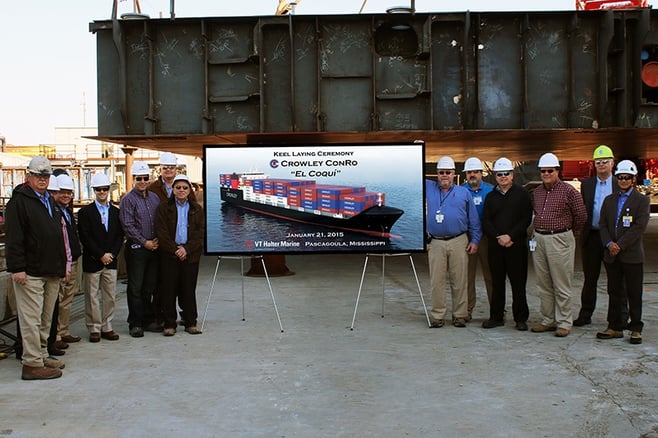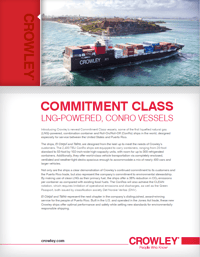 The keel for the first of two liquefied natural gas (LNG)-powered, combination container – Roll-On/Roll-Off (ConRo) ships for Crowley Maritime Corp .’s liner services group was laid today during a ceremony at ship-builder VT Halter Marine, Inc.’s facility in Pascagoula, Miss. The keel laying ceremony marked the next step in the construction of Crowley’s first Commitment Class ship, which will exclusively serve the U.S.-Puerto Rico trade lane.
The keel for the first of two liquefied natural gas (LNG)-powered, combination container – Roll-On/Roll-Off (ConRo) ships for Crowley Maritime Corp .’s liner services group was laid today during a ceremony at ship-builder VT Halter Marine, Inc.’s facility in Pascagoula, Miss. The keel laying ceremony marked the next step in the construction of Crowley’s first Commitment Class ship, which will exclusively serve the U.S.-Puerto Rico trade lane.
“A long-standing tradition, the keel laying marks the ceremonial beginning of the ship’s construction,” said Crowley’s Todd Busch , senior vice president and general manager, technical services. “The keel forms the backbone of a ship and is the first part of the ship to be constructed. We at Crowley are very excited to begin the construction process for these technically advanced ships.”
VT Halter Marine and Crowley entered into a contract for the pair of ships in November 2013 and construction began with the first steel plate cutting in Pascagoula on October 22, 2014. The shipbuilder began to assemble the keel once enough steel pieces had been cut. With the first section set into place, the ship will now begin to take shape as it is built around the keel.
“This keel laying is a major milestone event in the construction schedule for the Crowley Commitment-Class program,” said Bill Skinner, chief executive officer, VT Halter Marine. “We are pleased that construction is underway for this very significant vessel. We are most grateful to our valued customer, Crowley, for their continued confidence in VT Halter Marine.”
The Commitment Class ships have been designed to maximize the carriage of 53-foot, 102-inch-wide containers, which offer the most cubic cargo capacity in the trade. The ships will be 219.5 meters long, 32.3 meters wide (beam), have a deep draft of 10 meters, and an approximate deadweight capacity of 26,500 metric tons. Cargo capacity will be approximately 2,400 TEUs (20-foot-equivalent-units), with additional space for nearly 400 vehicles in an enclosed Roll-on/Roll-off garage. The main propulsion and auxiliary engines will be fueled by environmentally friendly LNG. The Commitment Class, Jones Act ships will replace Crowley’s towed triple-deck barge fleet in the South Atlantic trade, which has served the trade continuously and with distinction since the early 1970s. These new ships, which will be named El Coquí (ko-kee) and Taíno (tahy-noh), will offer customers fast ocean transit times, while accommodating the company’s diverse equipment selection and cargo handling flexibility – benefits customers have enjoyed for nearly 60 years. El Coquí and Taíno are scheduled for delivery during the second and fourth quarter 2017 respectively.
Powered by LNG, the Crowley ships will set a new standard for environmentally responsible shipping. LNG is a stable gas that is neither toxic nor corrosive and is lighter than air. It is the cleanest fossil fuel available, netting a 100-percent reduction in sulphur oxide (SOx) and particulate matter (PM), and a 92-percent reduction in nitrogen oxide (NOx). LNG also has the ability to significantly reduce carbon dioxide (CO2), a contributor to greenhouse gas emissions, as compared with conventional fossil fuels.
The ship design is provided by Wartsila Ship Design in conjunction with Crowley subsidiary Jensen Maritime, a leading Seattle-based naval architecture and marine engineering firm. Designing, building and operating LNG-powered vessels is very much in line with Crowley’s overall EcoStewardship© positioning and growth strategy. The company formed an LNG services group in 2014 to bring together the company’s extensive resources to provide LNG vessel design and construction management; transportation; product sales and distribution, and full-scale, project management solutions.
Crowley’s Todd Busch, senior vice president and general manager, technical services;; Tucker Gilliam, vice president, special projects; Ray Martus, vice president, construction management; and Cole Cosgrove, vice president, marine operations attended the ceremony.
{% set baseFontFamily = "Open Sans" %} /* Add the font family you wish to use. You may need to import it above. */
{% set headerFontFamily = "Open Sans" %} /* This affects only headers on the site. Add the font family you wish to use. You may need to import it above. */
{% set textColor = "#565656" %} /* This sets the universal color of dark text on the site */
{% set pageCenter = "1100px" %} /* This sets the width of the website */
{% set headerType = "fixed" %} /* To make this a fixed header, change the value to "fixed" - otherwise, set it to "static" */
{% set lightGreyColor = "#f7f7f7" %} /* This affects all grey background sections */
{% set baseFontWeight = "normal" %} /* More than likely, you will use one of these values (higher = bolder): 300, 400, 700, 900 */
{% set headerFontWeight = "normal" %} /* For Headers; More than likely, you will use one of these values (higher = bolder): 300, 400, 700, 900 */
{% set buttonRadius = '40px' %} /* "0" for square edges, "10px" for rounded edges, "40px" for pill shape; This will change all buttons */


